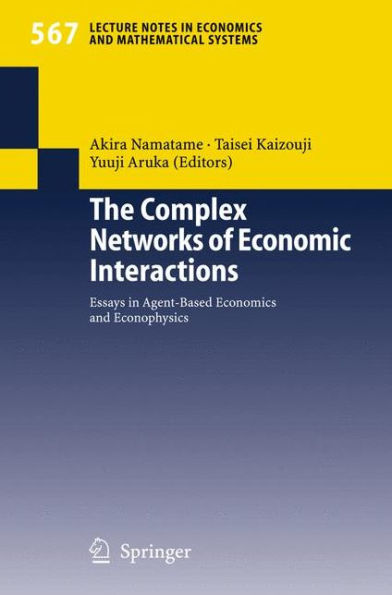The Complex Networks of Economic Interactions: Essays in Agent-Based Economics and Econophysics
Understanding the mechanism of a socio-economic system requires more than an understanding of the individuals that comprise the system. It also requires understanding how individuals interact with each other, and how the agg- gated outcome can be more than the sum of individual behaviors. This book contains the papers fostering the formation of an active multi-disciplinary community on socio-economic systems with the exciting new fields of age- based modeling and econophysics. We especially intend to increase the awareness of researchers in many fields with sharing the common view many economic and social activities as collectives of a large-scale heterogeneous and interacting agents. Economists seek to understand not only how individuals behave but also how the interaction of many individuals leads to complex outcomes. Age- based modeling is a method for studying socio-economic systems exhibiting the following two properties: (1) the system is composed of interacting agents, and (2) the system exhibits emergent properties, that is, properties arising from the interactions of the agents that cannot be deduced simply by agg- gating the properties of the system’s components. When the interaction of the agents is contingent on past experience, and especially when the agents continually adapt to that experience, mathematical analysis is typically very limited in its ability to derive the outcome.
1111355115
The Complex Networks of Economic Interactions: Essays in Agent-Based Economics and Econophysics
Understanding the mechanism of a socio-economic system requires more than an understanding of the individuals that comprise the system. It also requires understanding how individuals interact with each other, and how the agg- gated outcome can be more than the sum of individual behaviors. This book contains the papers fostering the formation of an active multi-disciplinary community on socio-economic systems with the exciting new fields of age- based modeling and econophysics. We especially intend to increase the awareness of researchers in many fields with sharing the common view many economic and social activities as collectives of a large-scale heterogeneous and interacting agents. Economists seek to understand not only how individuals behave but also how the interaction of many individuals leads to complex outcomes. Age- based modeling is a method for studying socio-economic systems exhibiting the following two properties: (1) the system is composed of interacting agents, and (2) the system exhibits emergent properties, that is, properties arising from the interactions of the agents that cannot be deduced simply by agg- gating the properties of the system’s components. When the interaction of the agents is contingent on past experience, and especially when the agents continually adapt to that experience, mathematical analysis is typically very limited in its ability to derive the outcome.
109.99
In Stock
5
1

The Complex Networks of Economic Interactions: Essays in Agent-Based Economics and Econophysics
347
The Complex Networks of Economic Interactions: Essays in Agent-Based Economics and Econophysics
347Paperback(2006)
$109.99
109.99
In Stock

Product Details
| ISBN-13: | 9783540287261 |
|---|---|
| Publisher: | Springer Berlin Heidelberg |
| Publication date: | 01/23/2006 |
| Series: | Lecture Notes in Economics and Mathematical Systems , #567 |
| Edition description: | 2006 |
| Pages: | 347 |
| Product dimensions: | 6.10(w) x 9.25(h) x 0.03(d) |
From the B&N Reads Blog
